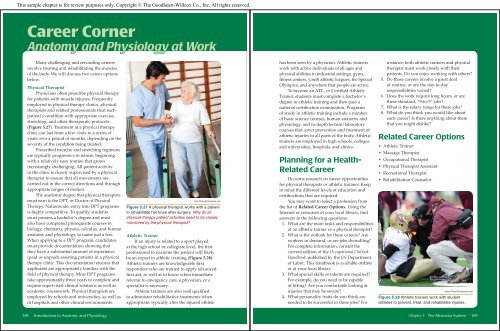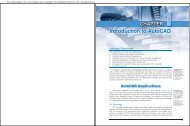Create successful ePaper yourself
Turn your PDF publications into a flip-book with our unique Google optimized e-Paper software.
This sample chapter is for review purposes only. Copyright © The <strong>Goodheart</strong>-<strong>Willcox</strong> Co., Inc. All rights reserved.<br />
Career Corner<br />
Anatomy and Physiology at Work<br />
Many challenging and rewarding careers<br />
involve treating and rehabilitating the muscles<br />
of the body. We will discuss two career options<br />
below.<br />
Physical Therapist<br />
Physicians often prescribe physical therapy<br />
for patients with muscle injuries. Frequently<br />
employed in physical therapy clinics, physical<br />
therapists and related professionals treat each<br />
patient’s condition with appropriate exercise,<br />
stretching, and other therapeutic protocols<br />
(Figure 5.27). Treatment at a physical therapy<br />
clinic can last from a few visits to a series of<br />
visits over a period of months, depending on the<br />
severity of the condition being treated.<br />
Prescribed exercise and stretching regimens<br />
are typically progressive in nature, beginning<br />
with a relatively easy routine that grows<br />
increasingly challenging. All patient activity<br />
in the clinic is closely supervised by a physical<br />
therapist to ensure that all movements are<br />
carried out in the correct directions and through<br />
appropriate ranges of motion.<br />
The academic degree that physical therapists<br />
must earn is the DPT, or Doctor of Physical<br />
Therapy. Nationwide, entry into DPT programs<br />
is highly competitive. To qualify, students<br />
must possess a bachelor’s degree and must<br />
also have completed prerequisite courses in<br />
biology, chemistry, physics, calculus, and human<br />
anatomy and physiology, to name just a few.<br />
When applying to a DPT program, candidates<br />
must provide documentation showing that<br />
they have a substantial amount of experience<br />
(paid or unpaid) assisting patients in a physical<br />
therapy clinic. This documentation ensures that<br />
applicants are appropriately familiar with the<br />
fi eld of physical therapy. Most DPT programs<br />
take approximately three years to complete and<br />
require supervised clinical rotations as well as<br />
academic coursework. Physical therapists are<br />
employed by schools and universities, as well as<br />
in hospitals and other clinical environments.<br />
188 Introduction to Anatomy and Physiology<br />
Tyler Olson/Shutterstock.com<br />
Figure 5.27 A physical therapist works with a patient<br />
to rehabilitate her knee after surgery. Why do all<br />
physical-therapy patient activities need to be closely<br />
monitored by the physical therapist?<br />
Athletic Trainer<br />
If an injury is related to a sport played<br />
at the high school or collegiate level, the fi rst<br />
professional to examine the patient will likely<br />
be an expert in athletic training (Figure 5.28).<br />
Athletic trainers are knowledgeable fi rst<br />
responders who are trained to apply advanced<br />
fi rst aid, as well as to know when immediate<br />
referral to emergency care, a physician, or a<br />
specialist is necessary.<br />
Athletic trainers are also well qualifi ed<br />
to administer rehabilitative treatments when<br />
appropriate, typically after the injured athlete<br />
has been seen by a physician. Athletic trainers<br />
work with active individuals of all ages and<br />
physical abilities in industrial settings, gyms,<br />
fi tness centers, youth athletic leagues, the Special<br />
Olympics, and anywhere that people are active.<br />
To become an ATC, or Certifi ed Athletic<br />
Trainer, students must complete a bachelor’s<br />
degree in athletic training and then pass a<br />
national certifi cation examination. Programs<br />
of study in athletic training include a number<br />
of basic science courses, human anatomy and<br />
physiology, and in-depth lecture/laboratory<br />
courses that cover prevention and treatment of<br />
athletic injuries to all parts of the body. Athletic<br />
trainers are employed in high schools, colleges<br />
and universities, hospitals, and clinics.<br />
Planning for a Health-<br />
Related Career<br />
Do some research on career opportunities<br />
for physical therapists or athletic trainers. Keep<br />
in mind the different levels of education and<br />
certifi cations that are required.<br />
You may want to select a profession from<br />
the list of Related Career Options. Using the<br />
Internet or resources at your local library, fi nd<br />
answers to the following questions:<br />
1. What are the main tasks and responsibilities<br />
of an athletic trainer or a physical therapist?<br />
2. What is the outlook for these careers? Are<br />
workers in demand, or are jobs dwindling?<br />
For complete information, consult the<br />
current edition of the Occupational Outlook<br />
Handbook, published by the US Department<br />
of Labor. This handbook is available online<br />
or at your local library.<br />
3. What special skills or talents are required?<br />
For example, do you need to be capable<br />
of lifting? Are you comfortable looking at<br />
injuries that may be severe?<br />
4. What personality traits do you think are<br />
needed to be successful in these jobs? For<br />
instance, both athletic trainers and physical<br />
therapist must work closely with their<br />
patients. Do you enjoy working with others?<br />
5. Do these careers involve a great deal<br />
of routine, or are the day-to-day<br />
responsibilities varied?<br />
6. Does the work require long hours, or are<br />
these standard, “9-to-5” jobs?<br />
7. What is the salary range for these jobs?<br />
8. What do you think you would like about<br />
each career? Is there anything about them<br />
that you might dislike?<br />
Related Career Options<br />
• Athletic Trainer<br />
• Massage Therapist<br />
• Occupational Therapist<br />
• Physical Therapist Assistant<br />
• Recreational Therapist<br />
• Rehabilitation Counselor<br />
Aspen Photo/Shutterstock.com<br />
Figure 5.28 Athletic trainers work with student<br />
athletes to prevent, treat, and rehabilitate injuries.<br />
<strong>Chapter</strong> 5 The Muscular System 189

















